The Variable Sky Through the OGLE Eye
Abstract
1. Introduction
2. Overview of the OGLE Project
3. The OGLE Collection of Variable Stars
- https://ogle.astrouw.edu.pl → OGLE Collection of Variable Stars(accessed on 11 July 2025)
- (accessed on 11 July 2025)
- The catalog data include observational parameters of the variable stars, such as coordinates, periods, mean magnitudes, brightness amplitudes, color indices, cross-matches with external catalogs, etc. Additionally, time-series OGLE photometry in the I- and V-bands is made available to the astronomical community. It is worth emphasizing that the OGLE classification pipeline is still semi-automatic, based on a combination of time-series analysis tools, and visual inspection of each light curve by team members. This led to exceptionally high completeness and a low contamination rate.
4. The OGLE Contributions to Variable Star Research
4.1. Classical Cepheids
4.2. Type II and Anomalous Cepheids
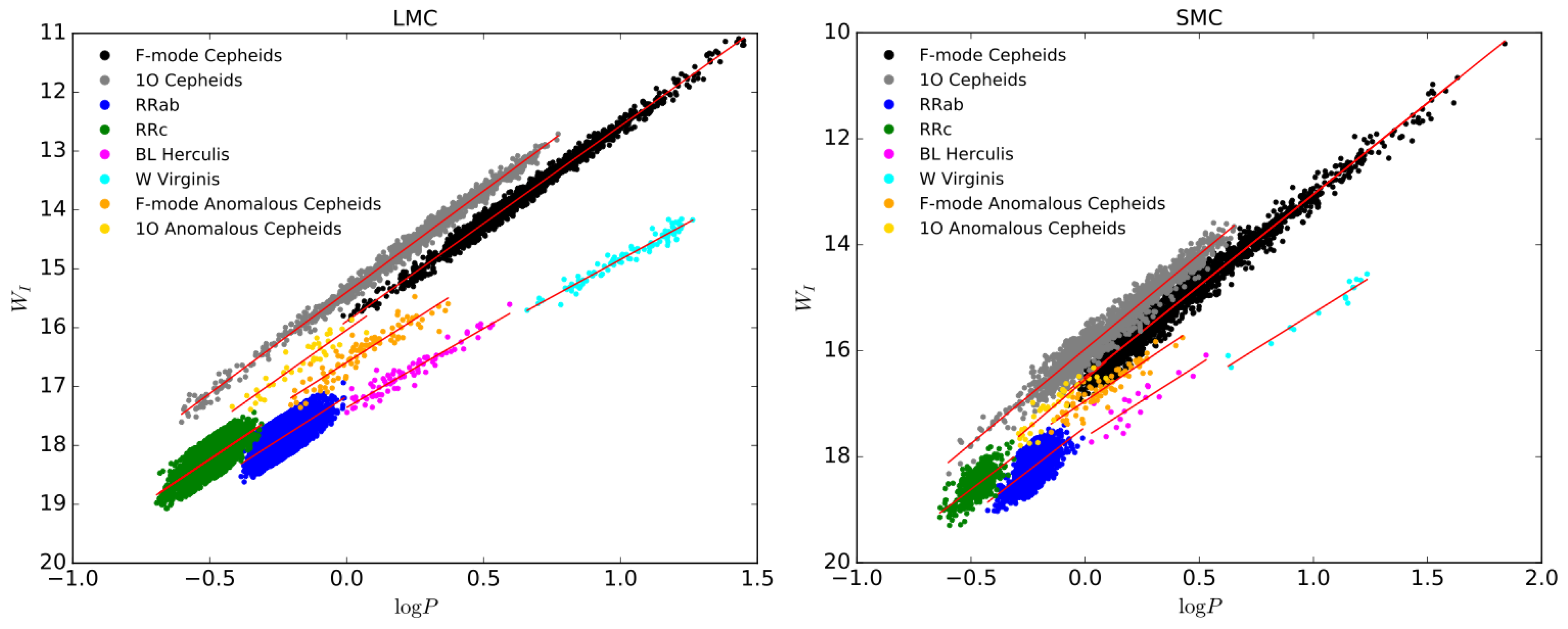
4.3. Miras
4.4. Blue Large-Amplitude Pulsators
4.5. Long Secondary Periods Variables
4.6. Millinovae
4.7. Supernovae
4.8. Rotating Variables
4.9. Exoplanets
5. Summary
Funding
Data Availability Statement
Acknowledgments
Conflicts of Interest
| 1 | The Wesenheit index is an extinction-free quantity, defined as WI = I − 1.55(V − I), where I and V are apparent mean magnitudes of the stars (see e.g., Soszyński et al. [81]). |
References
- Rauer, H.; Aerts, C.; Cabrera, J.; Deleuil, M.; Erikson, A.; Gizon, L.; Goupil, M.; Heras, A.; Walloschek, T.; Lorenzo-Alvarez, J.; et al. The PLATO mission. Exp. Astron. 2025, 59, 26. [Google Scholar] [CrossRef]
- Jetsu, L.; Porceddu, S.; Lyytinen, J.; Kajatkari, P.; Lehtinen, J.; Markkanen, T.; Toivari-Viitala, J. Did the Ancient Egyptians Record the Period of the Eclipsing Binary Algol—The Raging One? Astrophys. J. 2013, 773, 1. [Google Scholar] [CrossRef]
- Hevelius, J. Historiola Mirae Stellae. In Mercurius in Sole visus Gedani; Simon Reiniger: Gdańsk, Poland, 1662; pp. 146–171. [Google Scholar]
- Neuhäuser, R.; Neuhäuser, D.L.; Mugrauer, M.; Luge, D.; Chapman, J. The Mira discovery problem—Observations by David Fabricius in 1596 and 1609 (and by others before?): Positional accuracy, brightness, color index, and period. Astron. Nachr. 2024, 345, e20230131. [Google Scholar] [CrossRef]
- Hoskin, M. Goodricke, Pigott and the Quest for Variable Stars. J. Hist. Astron. 1979, 10, 23. [Google Scholar] [CrossRef]
- Bono, G.; Braga, V.F.; Pietrinferni, A. Cepheids as distance indicators and stellar tracers. Astron. Astrophys. Rev. 2024, 32, 4. [Google Scholar] [CrossRef]
- Leavitt, H.S. 1777 variables in the Magellanic Clouds. Ann. Harvard Coll. Obs. 1907, 60, 87–108.3. [Google Scholar]
- Leavitt, H.S.; Pickering, E.C. Periods of 25 Variable Stars in the Small Magellanic Cloud. Harv. Coll. Obs. Circ. 1912, 173, 1–3. [Google Scholar]
- Hertzsprung, E. Zur Stralung Der Strerne. WisZP 1907, 5, 86–107. [Google Scholar]
- Shapley, H. Studies based on the colors and magnitudes in stellar clusters. VI. On the determination of the distances of globular clusters. Astrophys. J. 1918, 48, 89–124. [Google Scholar] [CrossRef]
- Fernie, J.D. The Period-Luminosity Relation: A Historical Review. Publ. Astron. Soc. Pac. 1969, 81, 707. [Google Scholar] [CrossRef]
- Hubble, E. A Relation between Distance and Radial Velocity among Extra-Galactic Nebulae. Proc. Natl. Acad. Sci. USA 1929, 15, 168–173. [Google Scholar] [CrossRef]
- Breuval, L.; Huang, C.D.; Riess, A.G. The Legacy of Henrietta Leavitt: A Re-analysis of the First Cepheid Period–Luminosity Relation. Publ. Astron. Soc. Pac. 2025, 137, 044001. [Google Scholar] [CrossRef]
- Freedman, W.L.; Madore, B.F.; Gibson, B.K.; Ferrarese, L.; Kelson, D.D.; Sakai, S.; Mould, J.R.; Kennicutt, R.C.J.; Ford, H.C.; Graham, J.A.; et al. Final Results from the Hubble Space Telescope Key Project to Measure the Hubble Constant. Astrophys. J. 2001, 553, 47–72. [Google Scholar] [CrossRef]
- Riess, A.G.; Yuan, W.; Macri, L.M.; Scolnic, D.; Brout, D.; Casertano, S.; Jones, D.O.; Murakami, Y.; Anand, G.S.; Breuval, L.; et al. A Comprehensive Measurement of the Local Value of the Hubble Constant with 1 km s-1 Mpc-1 Uncertainty from the Hubble Space Telescope and the SH0ES Team. Astrophys. J. Lett. 2022, 934, L7. [Google Scholar] [CrossRef]
- van Gent, H. Provisional ephemerides of 63 new and 3 known variable stars in or near the constellation Corona Australis (Errata: 6 V). Bull. Astron. Inst. Neth. 1932, 6, 163. [Google Scholar]
- van Gent, H. Discussion of 122, mostly new, variable stars in or near the constellation Corona Australis. Bull. Astron. Inst. Neth. 1933, 7, 21. [Google Scholar]
- Campbell, W.W.; Wright, W.H. A list of nine stars whose velocities in the line of sight are variable. Astrophys. J. 1900, 12, 254–257. [Google Scholar] [CrossRef]
- Eggen, O.J. ρ Puppis: A New Short-Period Variable Star. Publ. Astron. Soc. Pac. 1956, 68, 238. [Google Scholar] [CrossRef]
- FROST, E.B. The period of beta Cephei. Astrophys. J. 1906, 24, 259–262. [Google Scholar] [CrossRef]
- Lesh, J.R.; Aizenman, M.L. The observational status of the beta Cephei stars. Annu. Rev. Astron. Astrophys. 1978, 16, 215. [Google Scholar] [CrossRef]
- Moskalik, P.; Dziembowski, W.A. New opacities and the origin of the β Cephei pulsation. Astron. Astrophys. 1992, 256, L5–L8. [Google Scholar]
- Sterken, C.; Jerzykiewicz, M. Beta Cephei stars from a photometric point of view. Space Sci. Rev. 1993, 62, 95–171. [Google Scholar] [CrossRef]
- Landolt, A.U. A New Short-Period Blue Variable. Astrophys. J. 1968, 153, 151. [Google Scholar] [CrossRef]
- McGraw, J.T. The physical properties of the ZZ Ceti stars and their pulsations. Astrophys. J. 1979, 229, 203–211. [Google Scholar] [CrossRef]
- Kopal, Z. Close Binary Systems; Wiley: Hoboken, NJ, USA, 1959. [Google Scholar]
- Abt, H.A.; Golson, J.C. Colors and Variability of Magnetic Stars. Astrophys. J. 1962, 136, 35. [Google Scholar] [CrossRef]
- Peterson, D.M. The Photometric Variability of AP Stars. Astrophys. J. 1970, 161, 685. [Google Scholar] [CrossRef]
- Preston, G.W. The chemically peculiar stars of the upper main sequence. Annu. Rev. Astron. Astrophys. 1974, 12, 257–277. [Google Scholar] [CrossRef]
- Hensberge, H.; Maitzen, H.M.; Deridder, G.; Gerbaldi, M.; Delmas, F.; Renson, P.; Doom, C.; Weiss, W.W.; Morguleff, N. A photoelectric investigation of light variability in AP stars. Astron. Astrophys. Suppl. Ser. 1981, 46, 151–170. [Google Scholar]
- Vogt, N. Photometric study of the dwarf nova VW Hydri. Astron. Astrophys. 1974, 36, 369–378. [Google Scholar]
- Warner, B. Observations of rapid blue variables-XV. VW Hydri. Mon. Not. R. Astron. Soc. 1975, 170, 219–228. [Google Scholar] [CrossRef][Green Version]
- Udalski, A. Photometry of cataclysmic variables. II. TT Arietis. Acta Astron. 1988, 38, 315–327. [Google Scholar][Green Version]
- Udalski, A.; Szymański, M. Photometry of cataclysmic variables. I. The 1987 September superoutburst of the dwarf nova AY Lyrae. Acta Astron. 1988, 38, 215–223. [Google Scholar][Green Version]
- Udalski, A.; Schwarzenberg-Czerny, A. Photometry of cataclysmic variables. IV. Nova V603 Aquilae: Discovery of a magnetic rotator. Acta Astron. 1989, 39, 125–138. [Google Scholar][Green Version]
- Udalski, A. SU Ursae Majoris: The Perfect Prototype of SU UMa Subclass of Dwarf Novae. Astron. J. 1990, 100, 226. [Google Scholar] [CrossRef]
- Udalski, A.; Kałużny, J. CCD Photometry of the X-ray Nova V404 Cygni after the 1989 Outburst. Publ. Astron. Soc. Pac. 1991, 103, 198. [Google Scholar] [CrossRef]
- Warner, B. Systematics of Surperoutbursts in Dwarf Novae. Astrophys. Space Sci. 1995, 226, 187–211. [Google Scholar] [CrossRef]
- Warner, B. Cataclysmic Variable Stars; Cambridge University Press: Cambridge, UK, 1995; Volume 28. [Google Scholar]
- Appenzeller, I.; Mundt, R. T Tauri stars. Astron. Astrophys. Rev. 1989, 1, 291–334. [Google Scholar] [CrossRef]
- Udalski, A.; Szymański, M.; Kałużny, J.; Kubiak, M.; Mateo, M. The Optical Gravitational Lensing Experiment. Acta Astron. 1992, 42, 253–284. [Google Scholar]
- Aubourg, E.; Bareyre, P.; Bréhin, S.; Gros, M.; Lachièze-Rey, M.; Laurent, B.; Lesquoy, E.; Magneville, C.; Milsztajn, A.; Moscoso, L.; et al. Evidence for gravitational microlensing by dark objects in the Galactic halo. Nature 1993, 365, 623–625. [Google Scholar] [CrossRef]
- Alcock, C.; Akerlof, C.W.; Allsman, R.A.; Axelrod, T.S.; Bennett, D.P.; Chan, S.; Cook, K.H.; Freeman, K.C.; Griest, K.; Marshall, S.L.; et al. Possible gravitational microlensing of a star in the Large Magellanic Cloud. Nature 1993, 365, 621–623. [Google Scholar] [CrossRef]
- Udalski, A.; Kubiak, M.; Szymański, M.; Kałużny, J.; Mateo, M.; Krzemiński, W. The Optical Gravitational Lensing Experiment. The Catalog of Periodic Variable Stars in the Galactic Bulge. I. Periodic Variables in the Center of the Baade’s Window. Acta Astron. 1994, 44, 317–386. [Google Scholar]
- Udalski, A.; Szymański, M.; Kałużny, J.; Kubiak, M.; Mateo, M.; Krzemiński, W. The Optical Gravitational Lensing Experiment. The Catalog of Periodic Variable Stars in the Galactic Bulge. II. Periodic Variables in Four Baade’s Window Fields: BW1, BW2, BW3 and BW4. Acta Astron. 1995, 45, 1–235. [Google Scholar]
- Udalski, A.; Olech, A.; Szymański, M.; Kałużny, J.; Kubiak, M.; Mateo, M.; Krzemiński, W. The Optical Gravitational Lensing Experiment. The Catalog of Periodic Variable Stars in the Galactic Bulge. III. Periodic Variables in Four Baades Window Fields: BW5, BW6, BW7 and BW8. Acta Astron. 1995, 45, 433–622. [Google Scholar]
- Udalski, A.; Olech, A.; Szymański, M.; Kałużny, J.; Kubiak, M.; Krzemiński, W.; Mateo, M.; Stanek, K.Z. The Optical Gravitational Lensing Experiment. The Catalog of Periodic Variable Stars in the Galactic Bulge. IV. Periodic Variables in Three Baade’s Window Fields: BW9, BW10, BW11. Acta Astron. 1996, 46, 51–231. [Google Scholar]
- Udalski, A.; Olech, A.; Szymański, M.; Kałużny, J.; Kubiak, M.; Mateo, M.; Krzemiński, W.; Stanek, K.Z. The Optical Gravitational Lensing Experiment. The Catalog of Periodic Variable Stars in the Galactic Bulge. V. Periodic Variables in Fields: MM5-A, MM5-B, MM7-A and MM7-B. Acta Astron. 1997, 47, 1–167. [Google Scholar]
- Alcock, C.; Allsman, R.A.; Alves, D.; Axelrod, T.S.; Becker, A.C.; Bennett, D.P.; Cook, K.H.; Freeman, K.C.; Griest, K.; Lacy, C.H.S.; et al. The MACHO Project LMC Variable Star Inventory.V.Classification and Orbits of 611 Eclipsing Binary Stars. Astron. J. 1997, 114, 326. [Google Scholar] [CrossRef]
- Alcock, C.; Allsman, R.A.; Alves, D.; Axelrod, T.S.; Becker, A.C.; Bennett, D.P.; Cook, K.H.; Freeman, K.C.; Griest, K.; Guern, J.; et al. The MACHO Project Large Magellanic Cloud Variable Star Inventory. III. Multimode RR Lyrae Stars, Distance to the Large Magellanic Cloud, and Age of the Oldest Stars. Astrophys. J. 1997, 482, 89–97. [Google Scholar] [CrossRef]
- Beaulieu, J.P.; Grison, P.; Tobin, W.; Pritchard, J.D.; Ferlet, R.; Lepeintre, F.; Vidal-Madjar, A.; Maurice, E.; Prevot, L.; Gry, C. et al. EROS variable stars: Fundamental-mode and first-overtone Cepheids in the bar of the Large Magellanic Cloud. Astron. Astrophys. 1995, 303, 137. [Google Scholar]
- de Laverny, P.; Beaulieu, J.P.; Asplund, M.; Kilkenny, D.; Renault, C.; Ferlet, R.; Marquette, J.B.; Vidal-Madjar, A.; Maurice, E.; Prevot, L.; et al. EROS variable stars: Discovery of a slow nova in the SMC. Astron. Astrophys. 1998, 335, L93–L96. [Google Scholar]
- Paczyński, B. Gravitational Microlensing by the Galactic Halo. Astrophys. J. 1986, 304, 1. [Google Scholar] [CrossRef]
- Udalski, A.; Szymański, M.; Kałużny, J.; Kubiak, M.; Krzemiński, W.; Mateo, M.; Preston, G.W.; Paczyński, B. The Optical Gravitational Lensing Experiment. Discovery of the First Candidate Microlensing Event in the Direction of the Galactic Bulge. Acta Astron. 1993, 43, 289–294. [Google Scholar]
- Udalski, A.; Kubiak, M.; Szymański, M. Optical Gravitational Lensing Experiment. OGLE-2—The Second Phase of the OGLE Project. Acta Astron. 1997, 47, 319–344. [Google Scholar]
- Udalski, A. The Optical Gravitational Lensing Experiment. Real Time Data Analysis Systems in the OGLE-III Survey. Acta Astron. 2003, 53, 291–305. [Google Scholar]
- Udalski, A.; Szymański, M.K.; Soszyński, I.; Poleski, R. The Optical Gravitational Lensing Experiment. Final Reductions of the OGLE-III Data. Acta Astron. 2008, 58, 69–87. [Google Scholar]
- Udalski, A.; Szymański, M.K.; Szymański, G. OGLE-IV: Fourth Phase of the Optical Gravitational Lensing Experiment. Acta Astron. 2015, 65, 1–38. [Google Scholar]
- Pietrzyński, G.; Kubiak, M.; Udalski, A.; Szymański, M. The Optical Gravitational Lensing Experiment. A CCD Search for Variable Stars in Open Clusters - NGC5999. Acta Astron. 1998, 48, 489–508. [Google Scholar]
- Pietrzyński, G.; Udalski, A. The Optical Gravitational Lensing Experiment. Variable Stars in Star Clusters of the Magellanic Clouds. I.Eclipsing Systems in the Clusters of the SMC. Acta Astron. 1999, 49, 149–155. [Google Scholar]
- Pietrzyński, G.; Udalski, A. The Optical Gravitational Lensing Experiment. Cepheids in Star Clusters from the Magellanic Clouds. Acta Astron. 1999, 49, 543–550. [Google Scholar]
- Soszyński, I. Classical Pulsators in Large-Scale Optical Photometric Surveys. In Proceedings of the The RR Lyrae 2017 Conference. Revival of the Classical Pulsators: From Galactic Structure to Stellar Interior Diagnostics, Niepołomice, Poland, 17–21 September 2017; Volume 6, pp. 29–36. [Google Scholar]
- Richards, J.W.; Starr, D.L.; Brink, H.; Miller, A.A.; Bloom, J.S.; Butler, N.R.; James, J.B.; Long, J.P.; Rice, J. Active Learning to Overcome Sample Selection Bias: Application to Photometric Variable Star Classification. Astrophys. J. 2022, 744, 192. [Google Scholar] [CrossRef]
- Aguirre, C.; Pichara, K.; Becker, I. Deep multi-survey classification of variable stars. Mon. Not. R. Astron. Soc. 2019, 482, 5078–5092. [Google Scholar] [CrossRef]
- Godines, D.; Bachelet, E.; Narayan, G.; Street, R.A. A machine learning classifier for microlensing in wide-field surveys. Astron. Comput. 2019, 28, 100298. [Google Scholar] [CrossRef]
- Becker, I.; Pichara, K.; Catelan, M.; Protopapas, P.; Aguirre, C.; Nikzat, F. Scalable end-to-end recurrent neural network for variable star classification. Mon. Not. R. Astron. Soc. 2020, 493, 2981–2995. [Google Scholar] [CrossRef]
- Mróz, P. Identifying Microlensing Events Using Neural Networks. Acta Astron. 2020, 70, 169–180. [Google Scholar] [CrossRef]
- Monsalves, N.; Jaque Arancibia, M.; Bayo, A.; Sánchez-Sáez, P.; Angeloni, R.; Damke, G.; Segura Van de Perre, J. Application of Convolutional Neural Networks to time domain astrophysics. 2D image analysis of OGLE light curves. Astron. Astrophys. 2024, 691, A106. [Google Scholar] [CrossRef]
- Li, M.Y.; Qian, S.B.; Zhu, L.Y.; Liao, W.P.; Chang, L.F.; Zhao, E.G.; Shi, X.D.; Li, F.X.; Sun, Q.B.; Li, P. Heartbeat Stars Recognition Based on Recurrent Neural Networks: Method and Validation. Astron. J. 2025, 170, 161. [Google Scholar] [CrossRef]
- Soszyński, I.; Udalski, A.; Szymański, M.K.; Wyrzykowski, Ł.; Ulaczyk, K.; Poleski, R.; Pietrukowicz, P.; Kozłowski, S.; Skowron, D.M.; Skowron, J.; et al. Concluding Henrietta Leavitt’s Work on Classical Cepheids in the Magellanic System and Other Updates of the OGLE Collection of Variable Stars. Acta Astron. 2017, 67, 103–113. [Google Scholar] [CrossRef]
- Pietrukowicz, P.; Soszyński, I.; Udalski, A. Classical Cepheids in the Milky Way. Acta Astron. 2021, 71, 205–222. [Google Scholar] [CrossRef]
- Pietrzyński, G.; Graczyk, D.; Gallenne, A.; Gieren, W.; Thompson, I.B.; Pilecki, B.; Karczmarek, P.; Górski, M.; Suchomska, K.; Taormina, M.; et al. A distance to the Large Magellanic Cloud that is precise to one per cent. Nature 2019, 567, 200–203. [Google Scholar] [CrossRef]
- Jacyszyn-Dobrzeniecka, A.M.; Skowron, D.M.; Mróz, P.; Skowron, J.; Soszyński, I.; Udalski, A.; Pietrukowicz, P.; Kozłowski, S.; Wyrzykowski, Ł.; Poleski, R.; et al. OGLE-ing the Magellanic System: Three-Dimensional Structure of the Clouds and the Bridge Using Classical Cepheids. Acta Astron. 2016, 66, 149–196. [Google Scholar]
- Jacyszyn-Dobrzeniecka, A.M.; Soszyński, I.; Udalski, A.; Szymański, M.K.; Skowron, D.M.; Skowron, J.; Mróz, P.; Kruszyńska, K.; Iwanek, P.; Pietrukowicz, P.; et al. OGLE-ing the Magellanic System: Cepheids in the Bridge. Astrophys. J. 2020, 889, 25. [Google Scholar] [CrossRef]
- Skowron, D.M.; Skowron, J.; Mróz, P.; Udalski, A.; Pietrukowicz, P.; Soszyński, I.; Szymański, M.K.; Poleski, R.; Kozłowski, S.; Ulaczyk, K.; et al. A three-dimensional map of the Milky Way using classical Cepheid variable stars. Science 2019, 365, 478–482. [Google Scholar] [CrossRef] [PubMed]
- Skowron, D.M.; Drimmel, R.; Khanna, S.; Spagna, A.; Poggio, E.; Ramos, P. The Milky Way as Seen by Classical Cepheids. I. Distances Based on Mid-infrared Photometry. Astrophys. J. Suppl. Ser. 2025, 278, 57. [Google Scholar] [CrossRef]
- Mróz, P.; Udalski, A.; Skowron, D.M.; Skowron, J.; Soszyński, I.; Pietrukowicz, P.; Szymański, M.K.; Poleski, R.; Kozłowski, S.; Ulaczyk, K. Rotation Curve of the Milky Way from Classical Cepheids. Astrophys. J. Lett. 2019, 870, L10. [Google Scholar] [CrossRef]
- Sofue, Y.; Honma, M.; Omodaka, T. Unified Rotation Curve of the Galaxy–Decomposition into de Vaucouleurs Bulge, Disk, Dark Halo, and the 9-kpc Rotation Dip–. Publ. Astron. Soc. Jpn. 2009, 61, 227. [Google Scholar] [CrossRef]
- Reid, M.J.; Menten, K.M.; Brunthaler, A.; Zheng, X.W.; Dame, T.M.; Xu, Y.; Wu, Y.; Zhang, B.; Sanna, A.; Sato, M. Trigonometric Parallaxes of High Mass Star Forming Regions: The Structure and Kinematics of the Milky Way. Astrophys. J. 2014, 783, 130. [Google Scholar] [CrossRef]
- Soszyński, I.; Skowron, D.M.; Udalski, A.; Pietrukowicz, P.; Gromadzki, M.; Szymański, M.K.; Skowron, J.; Mróz, P.; Poleski, R.; Kozłowski, S.; et al. Discovery of the Longest-period Classical Cepheid in the Milky Way. Astrophys. J. Lett. 2024, 965, L17. [Google Scholar] [CrossRef]
- Soszyński, I.; Udalski, A.; Szymański, M.K.; Kubiak, M.; Pietrzyński, G.; Wyrzykowski, Ł.; Ulaczyk, K.; Poleski, R.; Kozłowski, S.; Pietrukowicz, P. The Optical Gravitational Lensing Experiment. The OGLE-III Catalog of Variable Stars. XIII. Long-Period Variables in the Small Magellanic Cloud. Acta Astron. 2011, 61, 217–230. [Google Scholar]
- Soszyński, I.; Udalski, A.; Szymański, M.K.; Wyrzykowski, Ł.; Ulaczyk, K.; Poleski, R.; Pietrukowicz, P.; Kozłowski, S.; Skowron, D.; Skowron, J.; et al. The OGLE Collection of Variable Stars. Type II Cepheids in the Magellanic System. Acta Astron. 2018, 68, 89–109. [Google Scholar] [CrossRef]
- Soszyński, I.; Udalski, A.; Szymański, M.K.; Pietrzyński, G.; Wyrzykowski, Ł.; Ulaczyk, K.; Poleski, R.; Pietrukowicz, P.; Kozłowski, S.; Skowron, J.; et al. The OGLE Collection of Variable Stars. Anomalous Cepheids in the Magellanic Clouds. Acta Astron. 2015, 65, 233–250. [Google Scholar]
- Soszyński, I.; Udalski, A.; Szymański, M.K.; Kubiak, M.; Pietrzyński, G.; Wyrzykowski, Ł.; Szewczyk, O.; Ulaczyk, K.; Poleski, R. The Optical Gravitational Lensing Experiment. The OGLE-III Catalog of Variable Stars. II.Type II Cepheids and Anomalous Cepheids in the Large Magellanic Cloud. Acta Astron. 2008, 58, 293. [Google Scholar]
- Soszyński, I.; Udalski, A.; Szymański, M.K.; Wyrzykowski, Ł.; Ulaczyk, K.; Poleski, R.; Pietrukowicz, P.; Kozłowski, S.; Skowron, D.M.; Skowron, J.; et al. The OGLE Collection of Variable Stars. Classical, Type II, and Anomalous Cepheids toward the Galactic Center. Acta Astron. 2017, 67, 297–316. [Google Scholar] [CrossRef]
- Iwanek, P.; Soszyński, I.; Skowron, D.; Skowron, J.; Mróz, P.; Kozłowski, S.; Udalski, A.; Szymański, M.K.; Pietrukowicz, P.; Poleski, R.; et al. Three-Dimensional Distributions of Type II Cepheids and Anomalous Cepheids in the Magellanic Clouds. Do these Stars Belong to the Old, Young or Intermediate-Age Population? Acta Astron. 2018, 68, 213–236. [Google Scholar] [CrossRef]
- Soszyński, I.; Smolec, R.; Udalski, A.; Pietrukowicz, P. Type II Cepheids Pulsating in the First Overtone from the OGLE Survey. Astrophys. J. 2019, 873, 43. [Google Scholar] [CrossRef]
- Soszyński, I.; Smolec, R.; Udalski, A.; Szymański, M.K.; Pietrukowicz, P.; Skowron, D.M.; Skowron, J.; Mróz, P.; Poleski, R.; Kozłowski, S.; et al. OGLE-GAL-ACEP-091: The First Known Multi-mode Anomalous Cepheid. Astrophys. J. Lett. 2020, 901, L25. [Google Scholar] [CrossRef]
- Iwanek, P.; Soszyński, I.; Kozłowski, S. Mid-infrared Period-Luminosity Relations for Miras in the Large Magellanic Cloud. Astrophys. J. 2021, 919, 99. [Google Scholar] [CrossRef]
- Iwanek, P.; Kozłowski, S.; Gromadzki, M.; Soszyński, I.; Wrona, M.; Skowron, J.; Ratajczak, M.; Udalski, A.; Szymański, M.K.; Pietrukowicz, P.; et al. Multiwavelength Properties of Miras. Astrophys. J. Suppl. Ser. 2021, 257, 23. [Google Scholar] [CrossRef]
- Iwanek, P.; Soszyński, I.; Kozłowski, S.; Poleski, R.; Pietrukowicz, P.; Skowron, J.; Wrona, M.; Mróz, P.; Udalski, A.; Szymański, M.K.; et al. The OGLE Collection of Variable Stars: Nearly 66,000 Mira Stars in the Milky Way. Astrophys. J. Suppl. Ser. 2022, 260, 46. [Google Scholar] [CrossRef]
- Iwanek, P.; Poleski, R.; Kozłowski, S.; Soszyński, I.; Pietrukowicz, P.; Ban, M.; Skowron, J.; Mróz, P.; Wrona, M.; Udalski, A.; et al. A Three-dimensional Map of the Milky Way Using 66,000 Mira Variable Stars. Astrophys. J. Suppl. Ser. 2023, 264, 20. [Google Scholar] [CrossRef]
- Sormani, M.C.; Gerhard, O.; Portail, M.; Vasiliev, E.; Clarke, J. The stellar mass distribution of the Milky Way’s bar: An analytical model. Mon. Not. R. Astron. Soc. 2022, 514, L1–L5. [Google Scholar] [CrossRef]
- Pietrukowicz, P.; Kozłowski, S.; Skowron, J.; Soszyński, I.; Udalski, A.; Poleski, R.; Wyrzykowski, Ł.; Szymański, M.K.; Pietrzyński, G.; Ulaczyk, K.; et al. Deciphering the 3D Structure of the Old Galactic Bulge from the OGLE RR Lyrae Stars. Astrophys. J. 2015, 811, 113. [Google Scholar] [CrossRef]
- Pietrukowicz, P.; Dziembowski, W.A.; Latour, M.; Angeloni, R.; Poleski, R.; di Mille, F.; Soszyński, I.; Udalski, A.; Szymański, M.K.; Wyrzykowski, Ł.; et al. Blue large-amplitude pulsators as a new class of variable stars. Nat. Astron. 2017, 1, 0166. [Google Scholar] [CrossRef]
- Pietrukowicz, P.; Latour, M.; Soszyński, I.; Di Mille, F.; King, P.S.; Angeloni, R.; Poleski, R.; Udalski, A.; Szymański, M.K.; Ulaczyk, K.; et al. Observational Parameters of Blue Large-amplitude Pulsators. Astrophys. J. Suppl. Ser. 2025, 279, 21. [Google Scholar] [CrossRef]
- Borowicz, J.; Pietrukowicz, P.; Mróz, P.; Soszyński, I.; Udalski, A.; Szymański, M.K.; Ulaczyk, K.; Poleski, R.; Kozłowski, S.; Skowron, J.; et al. Blue Large-Amplitude Pulsators and Other Short-Period Variable Stars in the OGLE-IV Galactic Disk Fields. Acta Astron. 2023, 73, 1–19. [Google Scholar] [CrossRef]
- Borowicz, J.; Pietrukowicz, P.; Skowron, J.; Soszyński, I.; Udalski, A.; Szymański, M.K.; Ulaczyk, K.; Poleski, R.; Kozłowski, S.; Mróz, P.; et al. Blue Large-Amplitude Pulsators and Other Short-Period Variable Stars in OGLE-IV Fields of the Outer Galactic Bulge. Acta Astron. 2023, 73, 265–290. [Google Scholar] [CrossRef]
- Soszyński, I.; Udalski, A. The Light Curve Shapes as a Key to Resolving the Origin of Long Secondary Periods in Red Giant Stars. Astrophys. J. 2014, 788, 13. [Google Scholar] [CrossRef]
- Soszyński, I.; Olechowska, A.; Ratajczak, M.; Iwanek, P.; Skowron, D.M.; Mróz, P.; Pietrukowicz, P.; Udalski, A.; Szymański, M.K.; Skowron, J.; et al. Binarity as the Origin of Long Secondary Periods in Red Giant Stars. Astrophys. J. Lett. 2021, 911, L22. [Google Scholar] [CrossRef]
- Mróz, P.; Król, K.; Szegedi, H.; Charles, P.; Page, K.L.; Udalski, A.; Buckley, D.A.H.; Dewangan, G.; Meintjes, P.; Szymański, M.K.; et al. Millinovae: A New Class of Transient Supersoft X-Ray Sources without a Classical Nova Eruption. Astrophys. J. Lett. 2024, 977, L37. [Google Scholar] [CrossRef]
- Maccarone, T.J.; Nelson, T.J.; Brown, P.J.; Mukai, K.; Charles, P.A.; Rajoelimanana, A.; Buckley, D.A.H.; Strader, J.; Chomiuk, L.; Britt, C.T.; et al. Unconventional origin of supersoft X-ray emission from a white dwarf binary. Nat. Astron. 2019, 3, 173–177. [Google Scholar] [CrossRef]
- Alard, C.; Lupton, R.H. A Method for Optimal Image Subtraction. Astrophys. J. 1998, 503, 325–331. [Google Scholar] [CrossRef]
- Woźniak, P.R. Difference Image Analysis of the OGLE-II Bulge Data. I. The Method. Acta Astron. 2000, 50, 421–450. [Google Scholar]
- Wyrzykowski, Ł.; Kostrzewa-Rutkowska, Z.; Kozłowski, S.; Udalski, A.; Poleski, R.; Skowron, J.; Blagorodnova, N.; Kubiak, M.; Szymański, M.K.; Pietrzyński, G.; et al. OGLE-IV Real-Time Transient Search. Acta Astron. 2014, 64, 197–232. [Google Scholar]
- Kozłowski, S.; Udalski, A.; Wyrzykowski, Ł.; Poleski, R.; Pietrukowicz, P.; Skowron, J.; Szymański, M.K.; Kubiak, M.; Pietrzyński, G.; Soszyński, I.; et al. Supernovae and Other Transients in the OGLE-IV Magellanic Bridge Data. Acta Astron. 2013, 63, 1–19. [Google Scholar]
- Inserra, C.; Sim, S.A.; Wyrzykowski, L.; Smartt, S.J.; Fraser, M.; Nicholl, M.; Shen, K.J.; Jerkstrand, A.; Gal-Yam, A.; Howell, D.A.; et al. OGLE-2013-SN-079: A Lonely Supernova Consistent with a Helium Shell Detonation. Astrophys. J. Lett. 2015, 799, L2. [Google Scholar] [CrossRef]
- Poznanski, D.; Kostrzewa-Rutkowska, Z.; Wyrzykowski, L.; Blagorodnova, N. Bright but slow—Type II supernovae from OGLE-IV—implications for magnitude-limited surveys. Mon. Not. R. Astron. Soc. 2015, 449, 1753–1759. [Google Scholar] [CrossRef]
- Iwanek, P.; Soszyński, I.; Stępień, K.; Kozłowski, S.; Skowron, J.; Udalski, A.; Szymański, M.K.; Wrona, M.; Pietrukowicz, P.; Poleski, R.; et al. The OGLE Collection of Variable Stars: Over 18 000 Rotating Variables toward the Galactic Bulge. Acta Astron. 2024, 74, 1–25. [Google Scholar] [CrossRef]
- Iwanek, P.; Soszyński, I.; Skowron, J.; Udalski, A.; Stępień, K.; Kozłowski, S.; Mróz, P.; Poleski, R.; Skowron, D.; Szymański, M.K.; et al. 12,660 Spotted Stars toward the OGLE Galactic Bulge Fields. Astrophys. J. 2019, 879, 114. [Google Scholar] [CrossRef]
- Mao, S.; Paczyński, B. Gravitational Microlensing by Double Stars and Planetary Systems. Astrophys. J. Lett. 1991, 374, L37. [Google Scholar] [CrossRef]
- Gould, A.; Loeb, A. Discovering Planetary Systems through Gravitational Microlenses. Astrophys. J. 1992, 396, 104. [Google Scholar] [CrossRef]
- Udalski, A.; Szymański, M.; Mao, S.; Di Stefano, R.; Kałużny, J.; Kubiak, M.; Mateo, M.; Krzemiński, W. The Optical Gravitational Lensing Experiment: OGLE No. 7: Binary Microlens or a New Unusual Variable? Astrophys. J. Lett. 1994, 436, L103. [Google Scholar] [CrossRef]
- Bond, I.A.; Udalski, A.; Jaroszyński, M.; Rattenbury, N.J.; Paczyński, B.; Soszyński, I.; Wyrzykowski, L.; Szymański, M.K.; Kubiak, M.; Szewczyk, O.; et al. OGLE 2003-BLG-235/MOA 2003-BLG-53: A Planetary Microlensing Event. Astrophys. J. Lett. 2004, 606, L155–L158. [Google Scholar] [CrossRef]
- Cassan, A.; Kubas, D.; Beaulieu, J.P.; Dominik, M.; Horne, K.; Greenhill, J.; Wambsganss, J.; Menzies, J.; Williams, A.; Jørgensen, U.G.; et al. One or more bound planets per Milky Way star from microlensing observations. Nature 2012, 481, 167–169. [Google Scholar] [CrossRef]
- Zang, W.; Jung, Y.K.; Yee, J.C.; Hwang, K.H.; Yang, H.; Udalski, A.; Sumi, T.; Gould, A.; Mao, S.; Albrow, M.D.; et al. Microlensing events indicate that super-Earth exoplanets are common in Jupiter-like orbits. Science 2025, 388, 400–404. [Google Scholar] [CrossRef]
- Mróz, P.; Udalski, A.; Skowron, J.; Poleski, R.; Kozłowski, S.; Szymański, M.K.; Soszyński, I.; Wyrzykowski, Ł.; Pietrukowicz, P.; Ulaczyk, K.; et al. No large population of unbound or wide-orbit Jupiter-mass planets. Nature 2017, 548, 183–186. [Google Scholar] [CrossRef] [PubMed]
- Mróz, P.; Poleski, R.; Han, C.; Udalski, A.; Gould, A.; Szymański, M.K.; Soszyński, I.; Pietrukowicz, P.; Kozłowski, S.; Skowron, J.; et al. A Free-floating or Wide-orbit Planet in the Microlensing Event OGLE-2019-BLG-0551. Astron. J. 2020, 159, 262. [Google Scholar] [CrossRef]
- Udalski, A.; Paczyński, B.; Żebruń, K.; Szymański, M.; Kubiak, M.; Soszyński, I.; Szewczyk, O.; Wyrzykowski, L.; Pietrzyński, G. The Optical Gravitational Lensing Experiment. Search for Planetary and Low-Luminosity Object Transits in the Galactic Disk. Results of 2001 Campaign. Acta Astron. 2002, 52, 1–37. [Google Scholar]
- Konacki, M.; Torres, G.; Jha, S.; Sasselov, D.D. An extrasolar planet that transits the disk of its parent star. Nature 2003, 421, 507–509. [Google Scholar] [CrossRef]

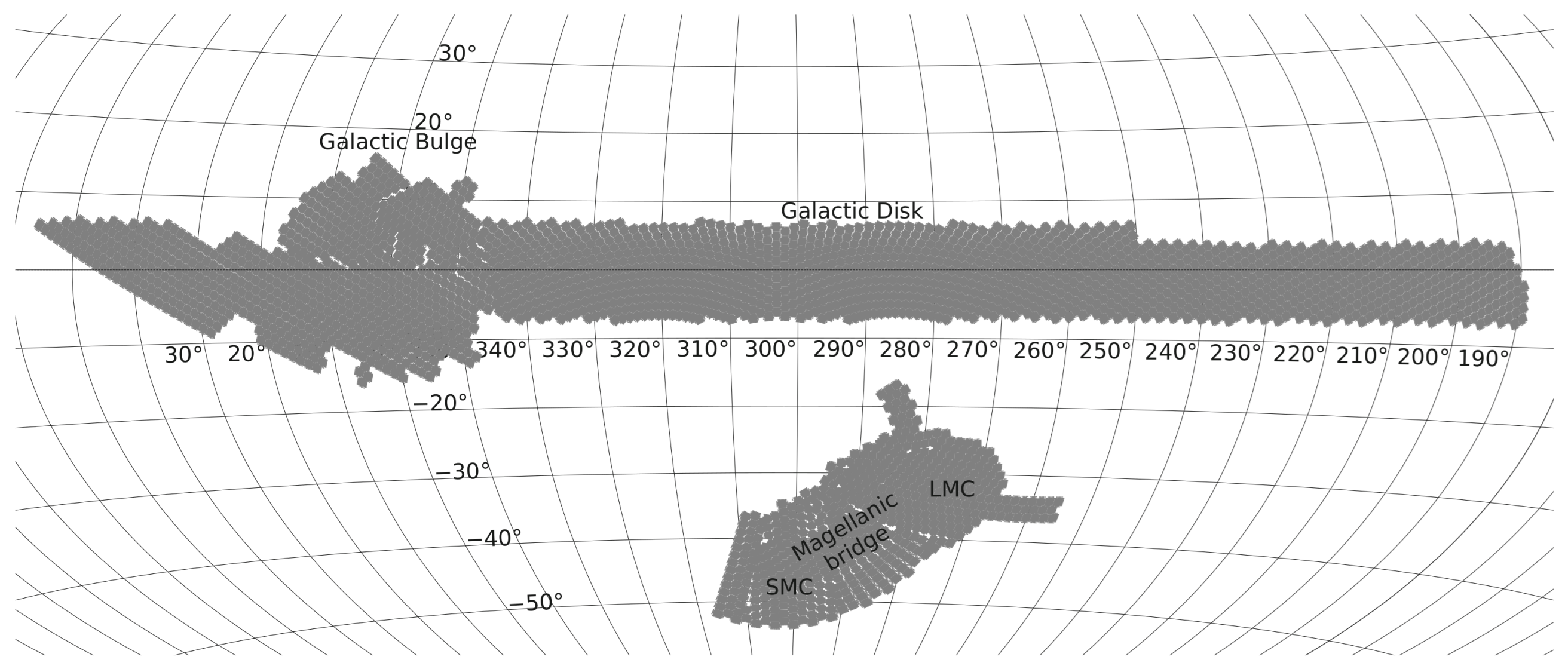

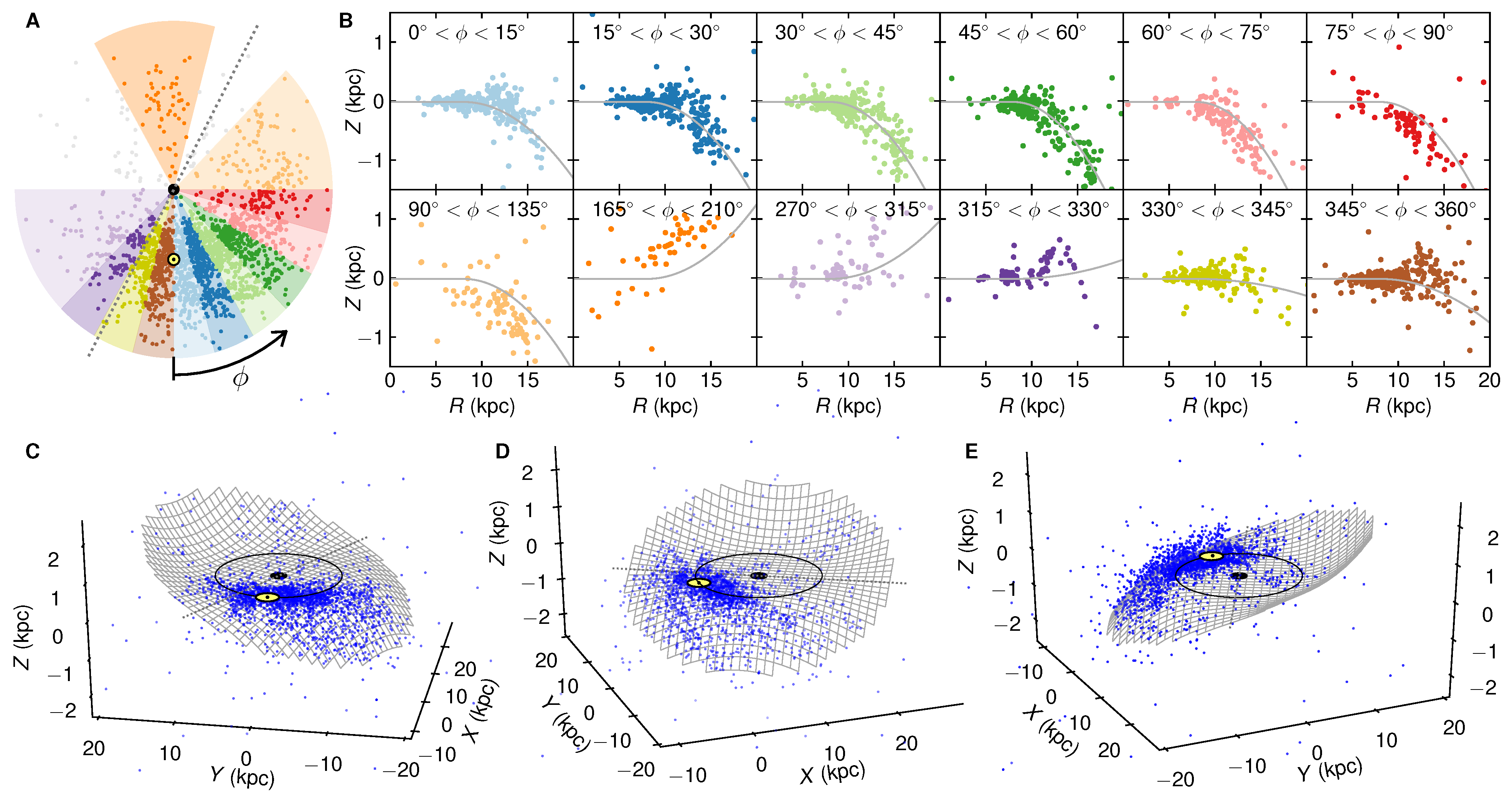
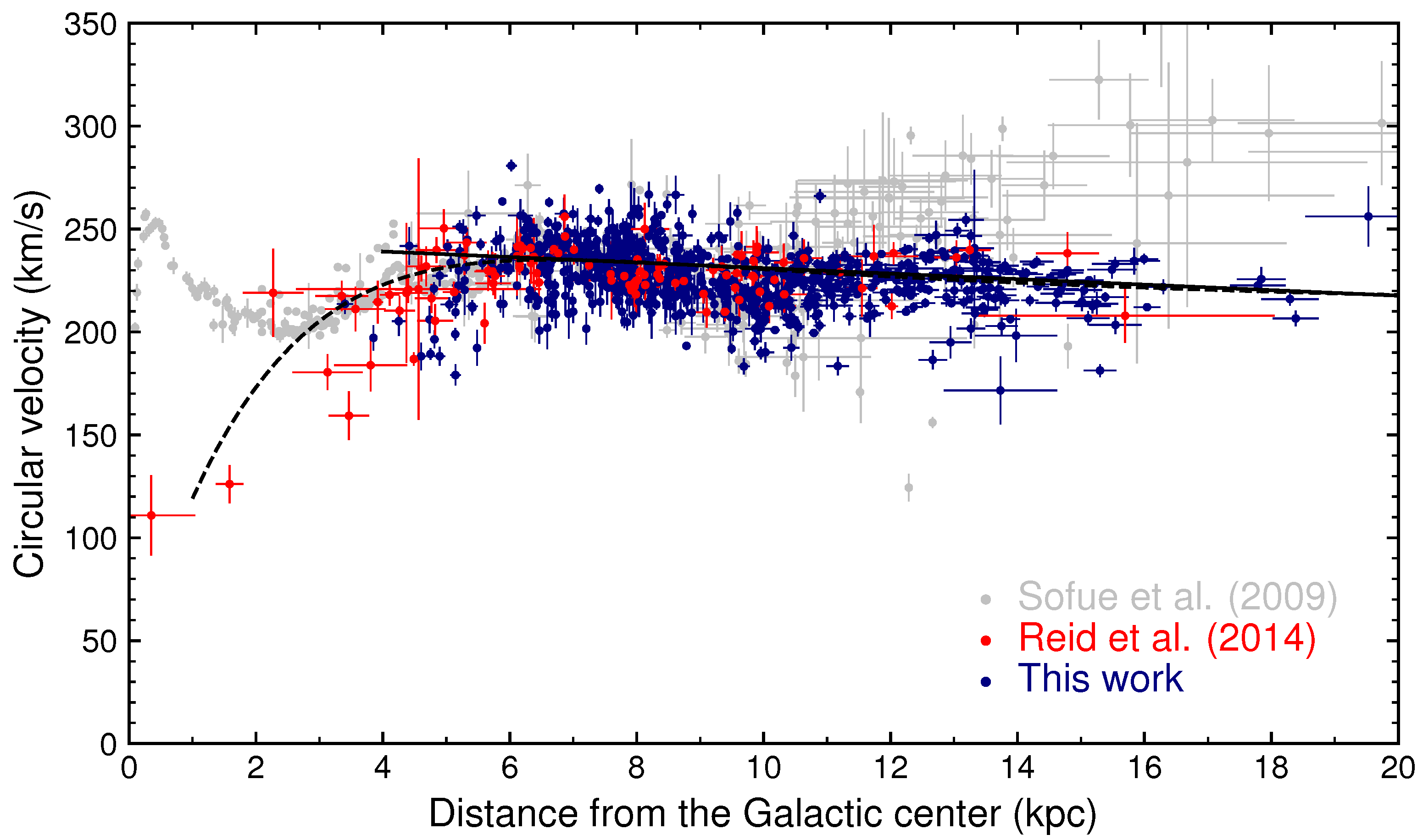
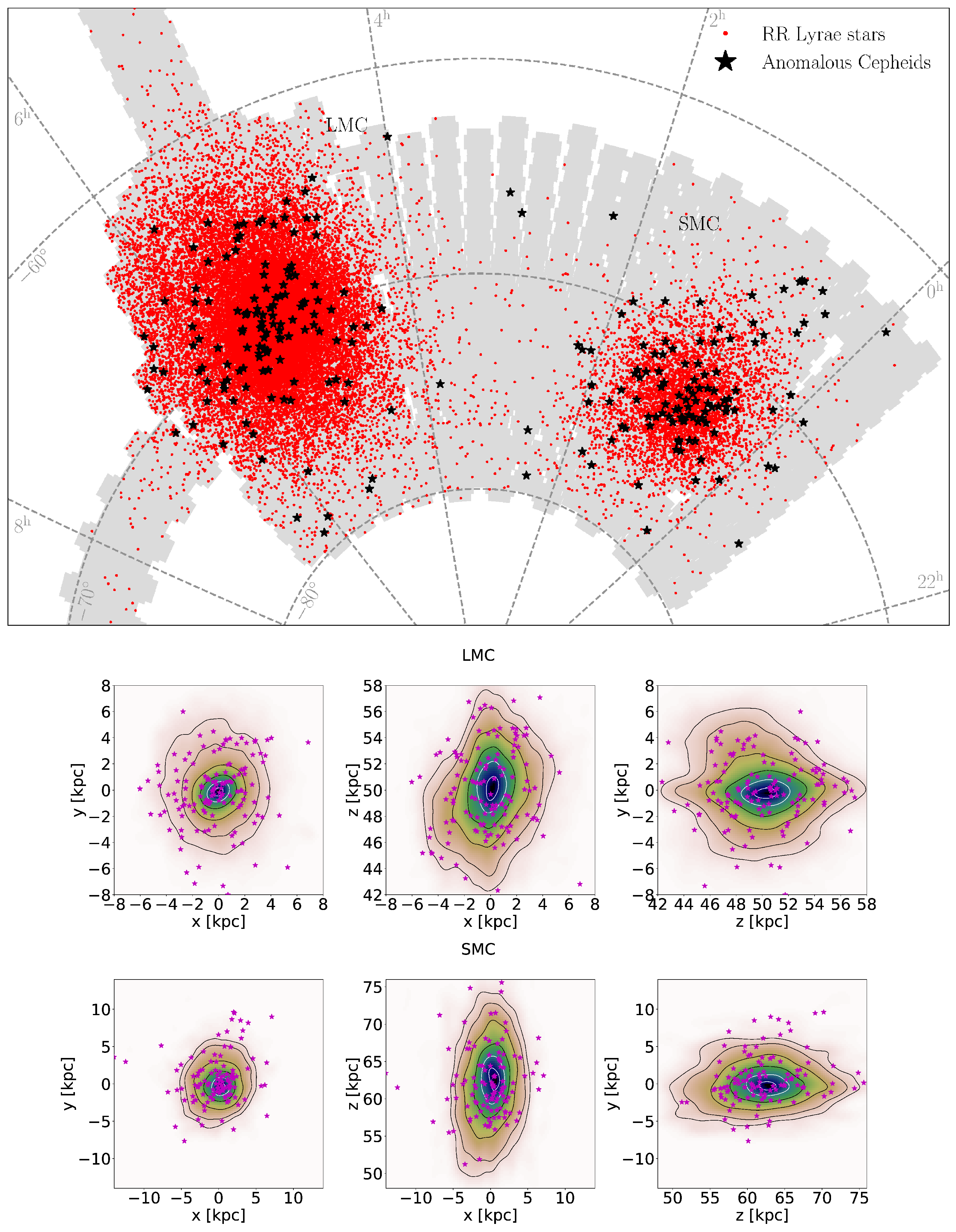

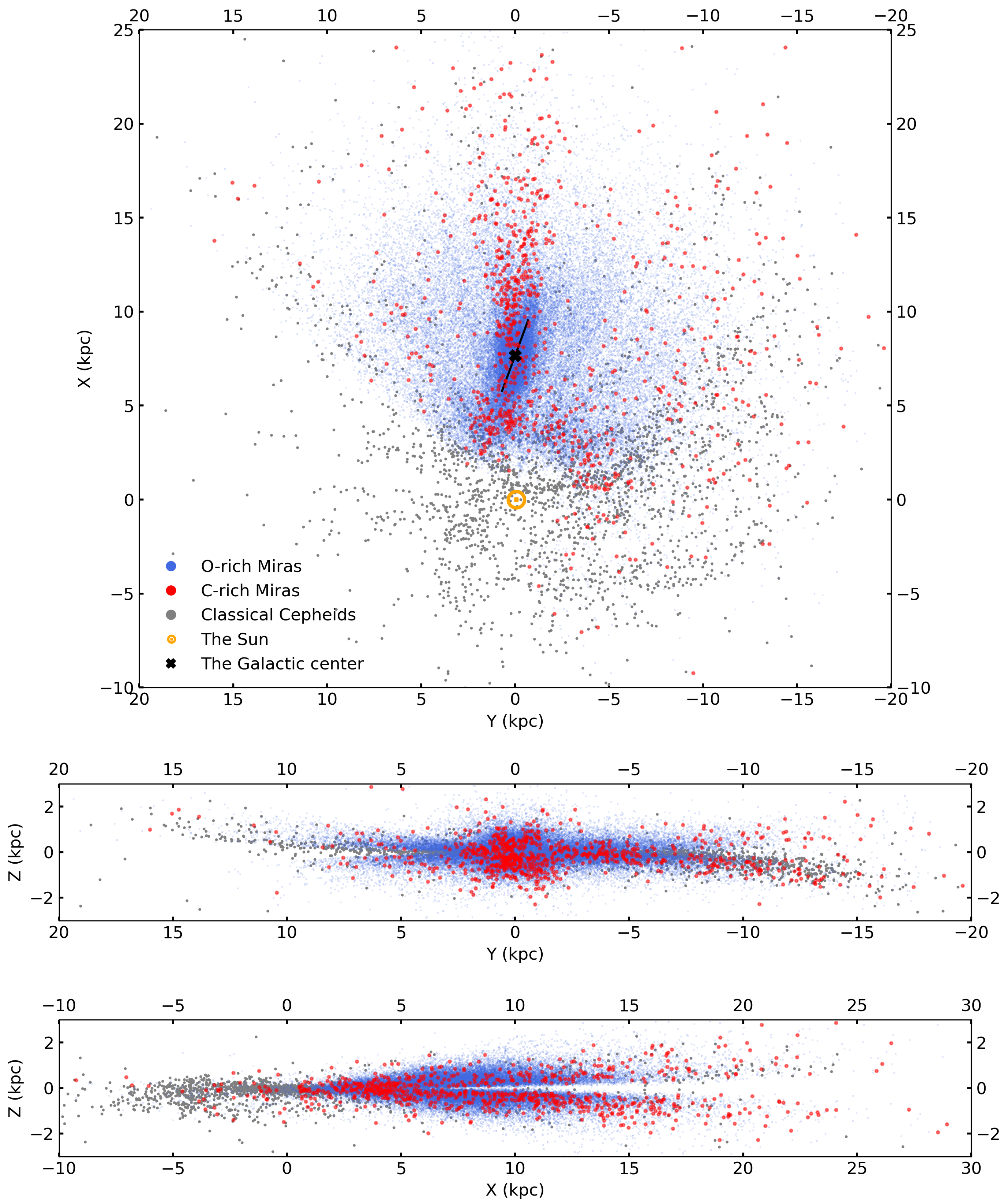

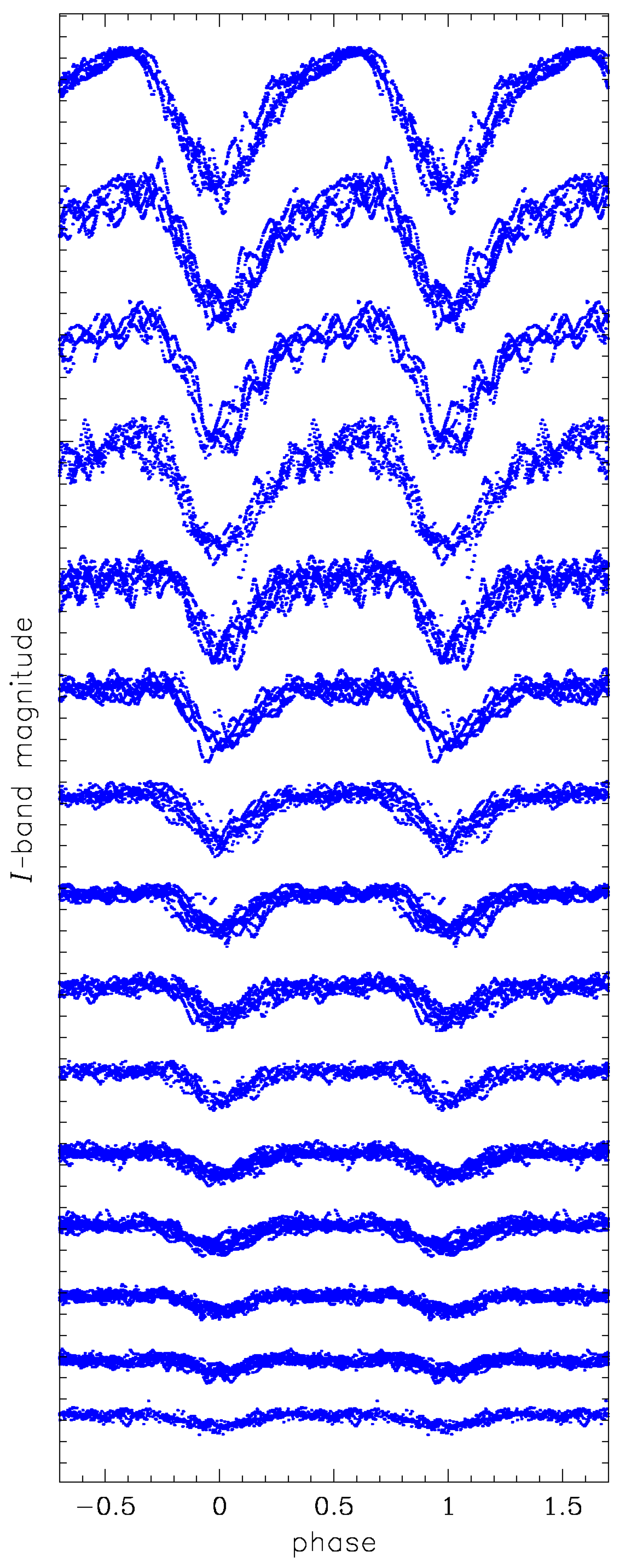
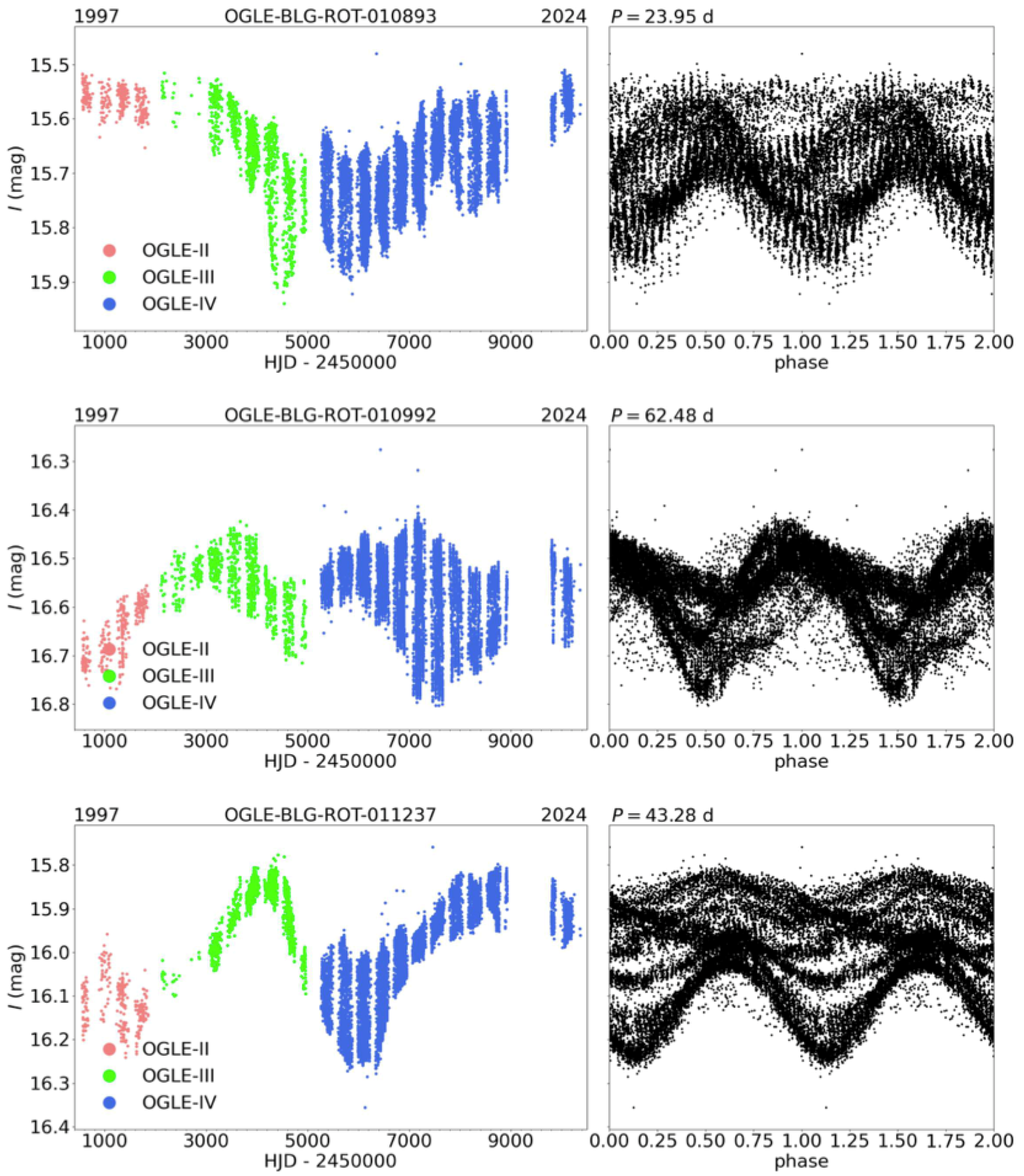
| Type of Variable Stars | Number of Stars |
|---|---|
| Classical Cepheids | 11,689 |
| Type II Cepheids | 2046 |
| Anomalous Cepheids | 393 |
| RR Lyrae stars | 129,740 |
| δ Scuti stars | 42,672 |
| Blue Large-Amplitude Pulsators | 94 |
| Long-Period Variables | 403,636 |
| Eclipsing binaries | 525,998 |
| Heartbeat stars | 991 |
| Rotating variables | 18,443 |
| Short-period eclipsing variables | 242 |
| R Coronae Borealis stars | 23 |
| Dwarf novae | 1091 |
| Double Periodic Variables | 32 |
| Total: | 1,137,090 |
Disclaimer/Publisher’s Note: The statements, opinions and data contained in all publications are solely those of the individual author(s) and contributor(s) and not of MDPI and/or the editor(s). MDPI and/or the editor(s) disclaim responsibility for any injury to people or property resulting from any ideas, methods, instructions or products referred to in the content. |
© 2025 by the author. Licensee MDPI, Basel, Switzerland. This article is an open access article distributed under the terms and conditions of the Creative Commons Attribution (CC BY) license (https://creativecommons.org/licenses/by/4.0/).
Share and Cite
Iwanek, P. The Variable Sky Through the OGLE Eye. Universe 2025, 11, 304. https://doi.org/10.3390/universe11090304
Iwanek P. The Variable Sky Through the OGLE Eye. Universe. 2025; 11(9):304. https://doi.org/10.3390/universe11090304
Chicago/Turabian StyleIwanek, Patryk. 2025. "The Variable Sky Through the OGLE Eye" Universe 11, no. 9: 304. https://doi.org/10.3390/universe11090304
APA StyleIwanek, P. (2025). The Variable Sky Through the OGLE Eye. Universe, 11(9), 304. https://doi.org/10.3390/universe11090304







